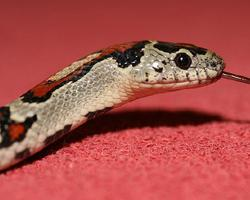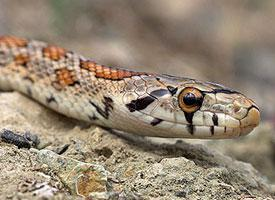
Weights and measures
| Length | 115 cm |
|---|
State of endangerment
| Non Endangered |
Animal description
The Mexican kingsnake (Lampropeltis mexicana) is a captivating species of non-venomous colubrid snake that is indigenous to Mexico. This particular species is a member of the genus Lampropeltis, which is well-known for its diverse array of kingsnakes and milk snakes, many of which boast striking color patterns and an impressive ability to adapt to a variety of habitats.The Mexican kingsnake has a robust and muscular body that is designed for strength and agility. They are typically moderate in length, with adults ranging from 3 to 4 feet, though some individuals may grow slightly longer. The scales of this species are smooth and glossy, which gives them a distinctive sheen that can be quite mesmerizing under the sunlight.
One of the most notable features of the Mexican kingsnake is its coloration and pattern. They exhibit a banded or chain-like pattern along their bodies, with contrasting colors that can include shades of black, white, yellow, red, or brown. The specific pattern and coloration can vary depending on the subspecies and the region in which they are found. The bold patterns serve not only as a stunning display but also as a form of camouflage, breaking up the snake's outline among leaves, rocks, and underbrush in its natural environment.
Mexican kingsnakes are typically found in a range of habitats, from semi-arid locales to wooded areas and even rocky outcrops. They are fairly adaptable and can thrive at various altitudes, often seen basking in the sun during the day to regulate their body temperature, as they are ectothermic animals.
As carnivorous reptiles, Mexican kingsnakes have a varied diet that includes rodents, birds, lizards, and other snakes, including venomous species. They are constrictors, meaning they subdue their prey by coiling around it and squeezing until the prey can no longer breathe, at which point the kingsnake swallows its meal whole. Their ability to consume venomous snakes is facilitated by their immunity to the venom of many native snake species, making them a formidable predator in their ecosystem.
In terms of behavior, Mexican kingsnakes are known for their docile temperament, especially when handled regularly. This, combined with their striking appearance, has made them popular in the pet trade. In captivity, with proper care, they can live for up to 20 years or more.
Breeding in Mexican kingsnakes typically occurs in the spring following their winter dormancy period. Females lay clutches of several eggs, which they deposit in hidden locations such as under rocks or within rotting logs. The eggs incubate for a period of time before the young snakes hatch, fully independent and ready to fend for themselves.
Conservation-wise, Mexican kingsnakes are not currently listed as endangered, but like many wildlife species, they face threats from habitat destruction and the illegal pet trade. It is important for their survival that their natural habitats be preserved and that any trade of these animals be conducted in a sustainable and regulated manner.
In summary, the Mexican kingsnake is a remarkable species that embodies both beauty and adaptability. Its diverse color patterns, resilience in various environments, and ecological role as a predator make it a fascinating subject of study and a treasured species for reptile enthusiasts.
Similar Animals
New photos of animals
Top 10 animals
- Dolphin gull (Leucophaeus scoresbii)
- Diana monkey (Cercopithecus diana)
- Moustached guenon (Cercopithecus cephus)
- Galápagos tortoise (Geochelone nigra complex)
- Stone loach (Barbatula barbatula)
- Greek tortoise (Testudo graeca)
- Japanese macaque (Macaca fuscata)
- Russian tortoise (Testudo horsfieldii)
- Common flying dragon (Draco volans)
- Galápagos penguin (Spheniscus mendiculus)


